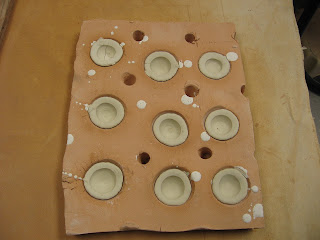Fluffers and gas milage
A ceramic fluffer glued to my jeep surface
It is often surprising for folks to discover just how dense
and sticky the air around really is.
While we, at our normal speed of movement (approaching 3 mph) don’t
notice the surrounding air, just stand in a pickup bed going 80 miles an hour,
or observe the nozzle end of a vacuum cleaner and you will quickly realize that
“at speed” air has an unusual ability to grab, hold on to, and pull along near
by objects. If air really was as
harmless as we usually imagine then tornados and hurricanes would not be a
human problem.
When air slides over a car’s surface it grabs the surfaces
and holds the car back. If we can break
this suction somehow, we can reduce air resistance and increase gas
mileage. Car designs and surface
treatments, such as car wax, might help reduce surface cohesion, but often,
these methods, because they stress flowing lines along smooth surfaces, really
don’t help much.
The only solution to breaking the suction of air to the car
surface, at speed, is to fluff up the air along the surface somehow, just
enough to allow the car to slip through the air with the least disruption of
the stable air possible. To accomplish
this successfully, air must be “fluffed” up at the car surface in some uniform
way. In other words, we want to move just the air necessary to travel through
it and not push gobs of air aside as this represents “work” and results in loss
of gas mileage.
Large fired clay mold for making lots of fluffers
These are slip cast but clay can also be pressed in the forms
The next problem was constructing enough fluffers to test
this scientific Fcat (my computer for
some reason won’t allow me to type the word “fact”?? not sure why). This post is mostly about how to construct
your own fluffers from ceramic material, much like the ceramic tiles that coat
space rockets. But to move on.
formed green clay fluffers to be dried and fired
Here is the ideal fluffer shape. To accomplish this I made molds of thick clay
slabs. These forms of mine are fired in
a ceramic kiln at 1835 degrees f, the standard bisque clay temperature, utilized
through out the world and clay classrooms.
Any clay student can then hand press clay into the forms or
pour clay slip and allow it to dry. In
either case, the dry bisque form will “release” the puppy fluffer (in it‘s
“puppy” state) for firing, again at bisque temperatures.
A single fluffer glued to a car, not much effect!
Next the fired fluffers must be glued to the car in an
organized manner. We have solved this
problem with silicone glue. Works
great. The fluffers must be glued in an
organized pattern all over your car in such a way as to distribute the fluffing
evenly. I estimate that it will take
about 40-60 fluffers per car.
Now for the final glue on.
Find a willing friend and glue the fluffers in place. You should have no problem as this will almost
certainly result in improved gas mileage, even for a Geo metro or other small
car that has difficulty reaching 100 mph.
and, a closer shot
DISCLAIMER: as of
today, in-spite of the great idea presented in this post, I still haven’t found
a friend who will let me glue fluffers on their car. Well, I’ll do a follow up post just as soon
as that happens.
I hope you like this post, it took almost 6 months of “R
& D’ to develop this remarkable idea.
We think it would work most effectively on race cars, gopher vacums, and
hand held tornados. Any ideas you might
have to further the “fluffer” are appreciated, and professional “fluffers” are
ask to not join in on this electronic interchange.
Garry oak in ieton Canyon, photo compliments of Jo Miles
Anyone can observe that if a tree, like this Garry oak In Tieton Canyon, had to sustain wind forces based on it's square foot cross section, they would fall down at the first gust. However, the individual leaves break up the moving air (fluff it) and reduce the drag of the wind through the willows. Without leaves, a tree would topple over almost as fast a leaves without a tree, or as we always say, "if there are more trees in a forest than leaves on any tree, than there will be at least two trees with the same number of leaves". Not sure what that proves??? Oh well, stay tuned for an actual magazine review in a week or so, you'll like it!!!







I'm still waiting for an entire car covered in fluffers. Have you contacted the mythbusters yet?
ReplyDelete